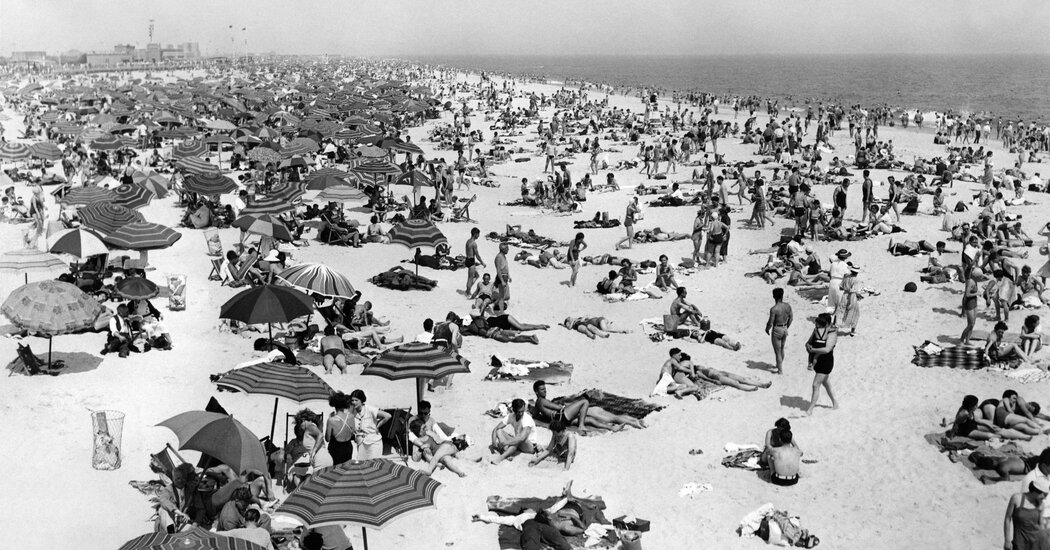By the time cool air from Canada’s Hudson Bay arrived to relieve the baking Upper Midwest in July 1936, the United States had sweat through a torrid heat spell that stretched to New York.
“North Winds Halt Hot Wave,” blared an exultant headline on the front page of The Chicago Daily Tribune on July 15, 1936.
The heat wave, which pushed temperatures to 100 degrees in Illinois and 120 degrees as far north as North Dakota, left some 5,000 people dead.
In New York, a high of 106 degrees was recorded in Central Park. Desperate for relief, people slept on roofs and fire escapes and flocked to public pools, which stayed open until midnight. New York City recorded 21 drownings as adults and children who didn’t know how to swim but were desperate to cool off jumped into the water.
The Dust Bowl, the drought in the Great Plains that was partially caused by agriculture practices, appeared to supercharge the heat wave. Its duration made it especially challenging: Temperatures hit 100 degrees for 12 straight days in Springfield, Ill., according to the National Weather Service.
Altered farming methods and better cooling technology may have staved off repeats of the 1936 heat wave since then. But the United States has had longer and more frequent heat waves in recent decades as the planet warms, according to government data.
In the summer of 2023, a ferocious, sustained heat wave settled over the Southwest. Phoenix logged temperatures of at least 110 degrees for 31 straight days, from June to July, smashing an 18-day modern record the city had set in 1974. Maricopa County, which surrounds Phoenix, reported 404 heat-related deaths in July.
The global air temperature likely was the hottest in modern times, scientists said.
This year, it seems, the United States may be in for another blistering summer.
An early-season heat wave has arrived in the Northeast and Midwest. In Chicago, the temperature hit a record-breaking 97 degrees on Monday. In New York, a high of 96 was forecast for Friday.
The period could be most punishing for a region stretching along the Ohio River and continuing into upstate New York and New England. Among the cities in the cross hairs were Pittsburgh and Cincinnati.
This heat wave could be similar to one in June 1994 that roasted Pittsburgh. That year, the temperature in the city reached 95 degrees for six straight days, a stretch of highs that could be matched or eclipsed this week, according to the local National Weather Service office.
Over the last three decades, concerns have grown about the dangers of extreme heat in urban areas.
In July 1995, a severe heat wave enveloped Chicago, hitting the city’s senior population especially hard. Neighborhoods lost power, hospitals filled up and, one day, the temperature reached a sticky 106 degrees. Morgues filled, and the death toll was later estimated at 739.
Because many of the people who died were older residents living alone, the heat wave served as a “turning point” in how many people think about heat waves, said Ashley Ward, director of the Heat Policy Innovation Hub at Duke University’s Nicholas Institute for Energy, Environment & Sustainability.
“The social and economic structure of society has a big impact on who dies,” she said.
Another factor influencing the human costs of heat waves: the novelty of extreme heat in regions not used to them.
Three years ago, typically mild Portland, Ore., was caught off-guard when the temperature climbed to 116 degrees. Researchers said that the heat was almost certainly energized by global warming and that there was 0.1 percent chance of such an event in any given year in the region.
One day, the high temperature at Portland International Airport was about 40 degrees warmer than normal. Although the heat wave only lasted a few days, it still had a devastating effect in the Pacific Northwest, where some do not have air-conditioning.
The medical examiner in Multnomah County, which includes Portland, attributed 69 deaths to the record-breaking temperatures. Before 2021, deaths from heat in the county were rare, with none recorded in 2016 or 2018, according to the medical examiner.
Most of the people who died in 2021 lacked air-conditioning, the medical examiner reported.
Portland’s unusual weather fulfilled old predictions that climate change would ultimately intensify heat waves in places where extreme heat was unfamiliar, climate experts said.
The 1936 heat wave may loom large in the history of U.S. heat waves. But J. Marshall Shepherd, the director of the University of Georgia’s atmospheric sciences program, said it should not be held up as an argument against evidence that climate change is now driving more extreme weather.
“Grass grows naturally, too,” he said, comparing grass to heat waves. “But when we fertilize our lawns, it grows differently.”
